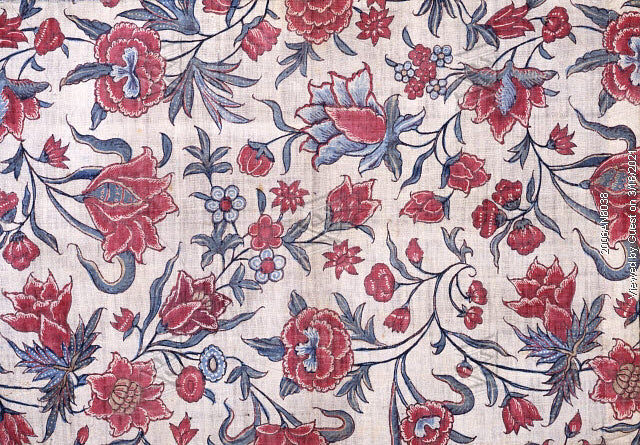
Sewing Seeds: The Cultural Significance of Flowers
In celebration of the Royal Horticultural Society's Chelsea Flower Show opening today, 21 May until 25 May 2024, we are republishing Sewing Seeds: The Cultural Significance of Flowers from Selvedge, issue 52. We hope you enjoy it.
Text by Sarah Jane Downing
Even for the least horticulturally minded, flowers fill our closets and our homes. You might eschew chintz or floral frocks, but there will be few who avoid the odd tea towel or embroidered handkerchief. Flowers have been regarded as nature’s jewels since the dawn of time, a fragrant symbol of blissful times in the Garden of Eden before the fall of man. Linking nature and sensuality, religion and spirituality, the flower is a sexual being without sex and symbol of God’s perfection.
For ancient Egyptians, Buddhists, and Hindus, the lotus blossom with its remarkable ability to bring forth beauty from the slime of marsh or river bed, and its simultaneous bearing of flower and fruit represents spiritual purity and enlightenment. The lotus or water lily also suggests reincarnation as its waxy seeds have a remarkable resilience and can germinate successfully even 200 years after being shed, but only in the correct conditions. Little in the way of Egyptian textiles survive but a fine linen tunic found in Tutankhamen’s tomb features a chain stitch embroidered panel with lotus design, and a tapestry woven cloth from the tomb of Tuthmosis IV has an all-over design of lilies and papyrus. Lotus motifs appear in Chinese embroidered robes and Japanese textiles, often stylised in wheel form to represent the cycle of life.
 Image: Woman's coif of linen, Blackwork, England, 1570-99. Image above: Chintz, Block printed cotton, India, 18th century.
Image: Woman's coif of linen, Blackwork, England, 1570-99. Image above: Chintz, Block printed cotton, India, 18th century.
The rose is a ubiquitous symbol of love and beauty, dating from Greek and Roman mythology when the rose became the flower of Venus, representing her love transcendent beyond life, after the death of Adonis. Like many ancient and pagan symbols the rose was adopted by Christianity to represent the Virgin Mary, and her mysterious union with Christ.
Text by Sarah Jane Downing
Even for the least horticulturally minded, flowers fill our closets and our homes. You might eschew chintz or floral frocks, but there will be few who avoid the odd tea towel or embroidered handkerchief. Flowers have been regarded as nature’s jewels since the dawn of time, a fragrant symbol of blissful times in the Garden of Eden before the fall of man. Linking nature and sensuality, religion and spirituality, the flower is a sexual being without sex and symbol of God’s perfection.
For ancient Egyptians, Buddhists, and Hindus, the lotus blossom with its remarkable ability to bring forth beauty from the slime of marsh or river bed, and its simultaneous bearing of flower and fruit represents spiritual purity and enlightenment. The lotus or water lily also suggests reincarnation as its waxy seeds have a remarkable resilience and can germinate successfully even 200 years after being shed, but only in the correct conditions. Little in the way of Egyptian textiles survive but a fine linen tunic found in Tutankhamen’s tomb features a chain stitch embroidered panel with lotus design, and a tapestry woven cloth from the tomb of Tuthmosis IV has an all-over design of lilies and papyrus. Lotus motifs appear in Chinese embroidered robes and Japanese textiles, often stylised in wheel form to represent the cycle of life.

The rose is a ubiquitous symbol of love and beauty, dating from Greek and Roman mythology when the rose became the flower of Venus, representing her love transcendent beyond life, after the death of Adonis. Like many ancient and pagan symbols the rose was adopted by Christianity to represent the Virgin Mary, and her mysterious union with Christ.
Want to read more of this article?
We are proud to be a subscriber-funded publication with members in 185 countries. We know our readership is passionate about textiles, so we invite you to help us preserve and promote the stories, memories, and histories that fabric holds. Your support allows us to publish our magazine, and also ‘what's on’ information, and subscription interviews, reviews, and long-read articles in our online blog.
ALREADY A SUBSCRIBER? CLICK HERE TO ACCESS CONTENT
OR...to continue reading….

*Magazine subscribers automatically get free access to all our online content. We send the access code by email with the publication of each issue. You will also find it on the envelope containing your magazine. Please note the access code changes every issue.*

*Magazine subscribers automatically get free access to all our online content. We send the access code by email with the publication of each issue. You will also find it on the envelope containing your magazine. Please note the access code changes every issue.*
